Think you know everything there is about tattoos? Well, here’s a quick refresher so you know what tattoos really are, before you get yourself inked.
The History of Tattoos
Experiencing tattoo pain dates back to more than 5,000 years ago. However, unlike today where artists use state-of-the-art machines to apply ink on one’s skin, early tattoos were done by cutting the skin and then applying charcoal directly into the wound. Back then, people never applied numbing cream for tattoos on their wounds. Although tattoos are often used as a way to mark criminals and slaves, some tribes use it to indicate the person’s status and accomplishments. It can be used as a rite of passage or as a mark to show off how many people a person has killed in his lifetime. Different cultures see tattoos in different ways. In Japan, it is seen as a form of art due to the intricate designs and the varied colors being used. In the US, however, they are mostly being associated with sailors, prisoners and gangsters. Today, society’s perception of tattoos has greatly changed. It is now being considered as a form of art and self-expression and each mark usually conveys a special meaning to each person.
Before Getting a Tattoo
Tattoos may be meaningless to some but it holds a special symbolism for others. Before you make your way to the tattoo parlor, make sure that you already have an idea of what body art to get – or you will regret it for the rest of your life. You should also keep in mind that even though a lot of people are already getting their own ink, you can still run the risk of getting infected if you are not careful. Choose only a reputable tattoo artist and make sure to follow through their aftercare instructions so your wounds heal correctly.
During the Tattoo Session
Many tattoo artists believe that pain during inking is all part of the process. However, there are some people who would rather see the art at the end of it all, which is why they use an anesthetic numbing spray to help them get through the pain. Make sure that you get plenty of rest and that you are well dehydrated prior to the tattoo session. Never get your ink done while you are drunk.
Tattoo Aftercare
Only remove the bandage after 24 hours and always keep the affected area clean. It is still possible for you to feel some pain after the anesthetic gel has worn off but it shouldn’t last very long. Be sure to apply moisturizer several times every day and to keep it away from direct sunlight as the colors might fade.
Getting Rid of a Tattoo
Removing a tattoo is a more difficult process compared to getting it. It is slow, expensive and can entail some level of pain. Also, it isn’t covered by insurance. The most difficult tattoos to remove are those with greens, reds and yellows and newer ones are also harder to remove than the older ones. It will probably take around 6 to 10 sessions to remove the tattoo out and it won’t be perfect or scar-free. You probably won’t be using a pain relieving cream during any of the sessions, either.





